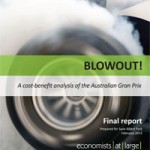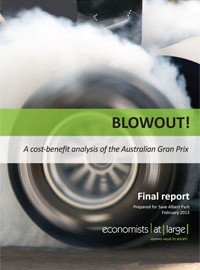
The 2012 Australian Grand Prix resulted in a net economic loss to Victoria of between $48.7m and $66.7m dollars, with a mid estimate of $60.6m.
These estimates include not only financial losses to the state, but also consideration of non-market values such as noise and park amenity, benefits of increased visitation to Victoria and the media exposure of the event. Sensitivity analysis on the less certain variables indicates that the magnitude of the loss is not affected by these values. There is no doubt that the race reduced the welfare of Victorians in 2012 by tens of millions of dollars.
|
|
VAGO (2007) analysis of 2005 Grand Prix |
Economists at Large analysis of 2011 Grand Prix |
Economists at Large analysis of 2012 Grand Prix |
|
Total operating costs |
68,100,000 |
85,132,000 |
97,185,000 |
|
Total revenues |
41,500,000 |
32,421,000 |
35,609,000 |
|
Net operating loss |
-26,600,000 |
-52,711,000 |
-61,576,000 |
|
Less other economic costs: |
|||
|
Other government costs |
500,000 |
415,000 |
419,150 |
|
Loss of park use and amenity |
400,000 |
2,689,506 |
2,716,401 |
|
Congestion |
500,000 |
598,000 |
603,980 |
|
Noise |
200,000 |
283,936 |
286,775 |
|
|
|||
|
Plus other economic benefits |
|||
|
Victorian spectator and public consumer surplus |
5,300,000 |
1,854,775 |
1,873,322 |
|
Net benefits of increased visitation |
5,400,000 |
2,878,000 |
2,906,780 |
|
Media exposure and induced tourism |
0 |
263,000 |
265,630 |
|
Mid estimate of net loss |
-6,700,000 |
-51,701,668 |
-60,556,574 |
The most important costs and benefits are based on financial data from the Australian Grand Prix Corporation annual reports. Like VAGO (2007), we include consideration of other economic and non-market costs and benefits, estimated with various methodologies. These costs and benefits accrue to various groups of Victorians. Our analysis focused on the 2011 event due to the availability of data relating to attendees in that year, which helped estimate these values and allowed extrapolation to the 2012 event.
Given the uncertainty surrounding many values, we have estimated best and worst case scenarios for the event. These scenarios compared net operating benefits to low estimates of other costs and high estimates of other benefits and vice versa.
|
|
VAGO (2007) analysis of 2005 Grand Prix |
Economists at Large analysis of 2011 Grand Prix |
Economists at Large analysis of 2012 Grand Prix |
|
Best case scenario estimate of net loss |
-800,000 |
-39,958,732 |
-48,696,210 |
|
Worst case scenario estimate of net loss |
-13,200,000 |
-57,735,776 |
-66,651,024 |
Given the magnitude of these loss estimates and the reliability of the major costs and benefits, our strong conclusion is that the race reduces the economic welfare of Victoria and that it should be discontinued.the degree of exposure through the media exist, this exposure only brings economic benefit if it attracts tourism and investment that would not otherwise occur. There is little evidence to suggest a material increase in tourism or investment actually occurs , however we have included some estimates of media value as it seems unlikely that the race’s exposure is entirely without benefit.
Coverage of the report in The Age here

